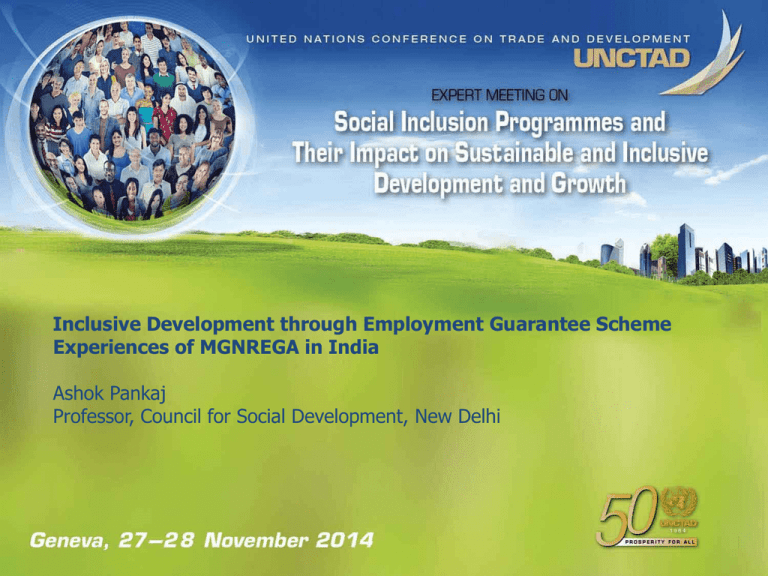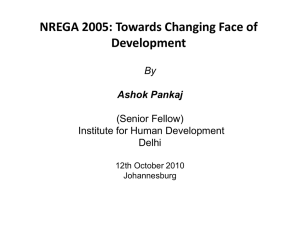Inclusive Development through Employment Guarantee Scheme Experiences of MGNREGA in India
advertisement

Inclusive Development through Employment Guarantee Scheme Experiences of MGNREGA in India Ashok Pankaj Professor, Council for Social Development, New Delhi Inclusive Development through Employment Guarantee Scheme Experiences of MGNREGA in India By Ashok Pankaj Professor, Council for Social Development, New Delhi (India) For Expert Meeting on Social Inclusion Programmes and Their Impact on Sustainable and Inclusive Development and Growth UNCTAD, GENEVA 27-28 November 2014 Structure of the presentation I. MGNREGS: A Programme for Inclusive development II. Implementation and impacts III. Lessons from MGNREGS experiences Inclusive development objectives of MGNREGA 1. Primary objectives Main objectives laid down by the Act (MGNREGA 2005): “ to provide for the enhancement of livelihood security of the households in rural areas of the country by providing at least one hundred days of guaranteed wage employment in every financial year to every household whose adult members volunteer to do unskilled manual work and for matters connected therewith or incidental thereto.” “Creation of durable assets and strengthening livelihood resource base of the rural poor…” (The NREGA 2005, The Gazette of India No. 48. Sept. 7, 2014). Objectives 2.Secondary objectives “ social safety net for the vulnerable groups by providing a fall-back employment [during lean season] Growth engine for sustainable development of an agricultural economy To strengthen the natural resource base of rural livelihood and create durable assets in rural areas. Empowerment of rural poor through the processes of a rights-based law. To promote transparent and accountable grassroots democracy and development” ( Operational Guidelines, 2008, 3rd edition, NREGS) : 3. Derivative objectives To reduce distress migration Women’s empowerment Programme features 1. Right to work a legal guarantee: (An Act of Parliament) 2. Demand driven (previous schemes supply driven) 3 . Entitlement to: a. Minimum wages b. Unemployment allowance and compensation due to delayed wage payment c. Four facilities at worksite : first aid, drinking water, shelter and crèche for children below six years 4. Priority to women workers ( one-third of total) 5. Priority to wage work (wage material cost in the ratio of 60:40 and works of water conservation top priority) 6. Funded by the Federal Government (100 % of the wage cost of unskilled workers and 75 % of the material and wage cost of skilled and semi-skilled workers) 7. Decentralised planning and execution (Institutions of local self-governance (PRIs) are the principal agencies for planning, implementation and monitoring of the works) 8. Civil society oriented (transparency and accountability through social audit) 9. Three tier grievance redressal mechanisms Implementation Overview (As on July 10, 2014) • 1720.7 crore ( 17.20 billion) persondays of employment have been generated so far. • Rs. 2,55,862.95 cores (2558.62 billion rupees) have been spent since the commencement of the programme in 2006. • About 70 percent of the total expenditure has been incurred on wages. • The Scheme has provided job to about five crore (fifty million) rural households every year since 2008 when the programme was extended to all the rural districts of the country. – The number of households and persons provided employment exceeds the total population of many a country of the world – Huge number of community assets mostly related to water conservation and harvesting, irrigation and drought control, rural connectivity, etc. have also been created under the programme. Implementation Overview Employment generated and provided 200607 2007- 2008- 2009- 2010- 2011- 2012- 201308 09 10 11 12 13 14 Households provided employment (in million) 21.01 33.9 Households provided (% of total rural households) 45.11 52.58 54.83 50.06 49.9 15.26 24.62 32.75 38.14 39.81 47.9 36.22 34.77 36.73 Household completing 100 days out of those provided employment 10.2 … 14.45 13.47 10.20 9.22 10.36 9.27 Average persondays per Households 43 42 48 46 54 47 43 46 Implementation overview Total No. of Job Cards [In million] Total No. of Workers [In million] SC worker as % of total Workers [In million] ST worker as % of total Workers [In million] Total No. of Active Job Cards [In million] Total No. of Active Workers [In million] SC worker as % of total Workers ST worker as % of total Workers 130 280 190 14.95 60 100 21.06 16.52 How does it promote inclusive growth and development? Some evidences Who are the beneficiaries of the programme (All India) Distribution of employment generated 200607 % Share of SC population in total persondays 25 27 29 30 36 29 25 21 43 45 49 49 43 48 48 48 % share of ST population in total persondays % share of other population in total persondays % share of women in total persondays 38 41 2007- 2008- 2009- 201008 09 10 11 31 21 201112 22 2012- 201313 14 22 22 17 17 59 60 60 48 53 51 19 Who are the beneficiaries of the programme Field based evidences from the two poorest states of India (surveyed in 2008) Land and occupation categories of beneficiaries Landless > 0.5 acres 0.5 to 1 acres 1 to 2.5 acres 2.5 to 5 acres 5 to 10 acres Above 10 acres Occupation Self-employed in agriculture Casual labourers in agriculture Casual labourers in non-agriculture Self-employed in small business Self-employed in large business/Salaried Others Total Bihar 80.41 13.65 3.16 2.04 0.37 0.37 0.00 Jharkhand 29.95 28.38 20.63 13.72 6.18 1.15 0.00 5.01 77.99 15.60 1.02 21.88 40.21 34.45 2.20 0.09 0.28 100.00 0.73 0.52 100.00 Households Provided Employment as Ratio of BPL Households In Bihar and Jharkhand 80 In % 60 40 20 0 -7 6 0 20 -8 7 0 20 -9 8 0 20 Ratio of BPL HH in Bihar 10 09 0 2 11 10 0 2 Ratio of BPL HH in Jharkhand Impacts on income and livelihood security Share of NREGS Earnings in the Total Annual Income of a Beneficiary Household Categories Caste Upper Caste OBC-I OBC-II SC ST Average NREGA Income as % of the Total Annual Income of a Household Bihar 3.29 5.14 4.22 11.74 2.74 Jharkhand 0.27 1.55 2.36 0.97 3.91 8.90 7.81 2.31 8.37 0.89 3.18 2.02 1.39 2.41 Land Landless Marginal Small Medium Total Other sources of income of a beneficiary (2008) Income of NREGA Beneficiary from Various Sources in Bihar Remittance 8% Salaried & pension 3% NREGA 8% Others 0% Agri 9% Animal 2% Business 2% Trad Services 1% Const & other 6% Non Agri Lab 22% Agri Lab 39% What do they do with the income: Meet food security, promote education and health as priority Distribution of Expenditure from NREGS Earnings in Bihar (%) 2007-08 Land/House, 0.29 Social Ceremonies, 6.19 Animal, 1.27 Productive Asset, 1.53 Others, 1.53 Loan repayment, 1.99 Education, 4.17 Health, 7.54 Food & Other consumption , 71.31 Household Durable, 4.2 Other direct benefits to the individual beneficiaries • Reduction in indebtedness (due to lean season employment) • Reduction in distress migration • Dependence on and exploitation by landlords decreased • Land-labour relations have changed • Bargaining power of the workers has increased Macro-level impacts Impacts of community assets on rural and agrarian economy • Types of assets created important • Increase in agricultural productivity • Uncultivated area brought under cultivation • Inclusion of large number of people as possible beneficiaries of assets creation has long term inclusive benefits • A large number of erstwhile households with unirrigated and uncultivated land have been converted into farmers. • (In Deccan area, they became cotton grower: 2 acres of land irrigated by one well constructed under NREGA) Types of Assets created between 2008-11 ( All India) Others, 1.99 Land development, 13.92 Rural Connectivity, 17.61 Flood Control, 3.79 Irrigation combined , 32.78 Water Conservation, 21.77 Drought Proofing, 8.14 New types of assets included Individual Assets for Vulnerable Sections (Only for Households in Paragraph 5 of Schedule I) (a)Scheduled Castes (b)Scheduled Tribes (c)nomadic tribes (d)denotified tribes (e)other families below the poverty line (f)women-headed households (g)physically handicapped headed households (h)beneficiaries of land reforms -the beneficiaries under the Indira Awaas Yojana -beneficiaries under the Scheduled Tribes and Other Traditional Forest Dwellers (Recognition of Forest Rights) Act, 2006 (2 of 2007). -After exhausting the eligible beneficiaries under the above categories, on lands of the small or marginal farmers (as defined in the Agriculture Debt Waiver and Debt Relief Scheme, 2008) Works on individual land (i) Improving productivity of lands of households specified in Paragraph 5 of Schedule I through land development and by providing suitable infrastructure for irrigation including dug wells, farm ponds and other water harvesting structures; (ii) Development of fallow or waste lands of households defined in Paragraph 5 of Schedule I to bring it under cultivation; Other new works included (i) Improving livelihoods through horticulture, sericulture, plantation, and farm forestry; (ii) Unskilled wage component in construction of houses sanctioned under the Indira Awaas Yojana or such other State or Central Government Scheme; (iii) Creating infrastructure for promotion of livestock such as, poultry shelter, goat shelter, piggery shelter, cattle shelter and fodder troughs for cattle; and (iv) Creating infrastructure for promotion of fisheries such as, fish drying yards, storage facilities, and promotion of fisheries in seasonal water bodies on public land; Impacts through wages • Upward push to the wages: low level equilibrium has been disturbed if not totally broken (Post-NREGA rise in wages is phenomenal compared to preNREGA period and since independence) • For the first time some serious implementation of Minium Wages Act • Theoretical and practical examples of higher wages resulting in faster reduction of poverty • Male-female wage wage parity in rural labour market with long term implications for labour market as a whole Reduction in male-female wage disparity (survey in 2009-10) Districts Average Earning of Minimum Wages a Woman Worker Under MGNREGS (per day in Rs.) (per day in Rs.)# Dungarpur District-wise Average Rural Wage of Casual Worker 2004–05 (per day in Rs.) 81 100 52.06* 65 89 36.17** Kangra 100 100 Ranchi 83 92 Gaya 50.21*** Women’s Empowerment Women’s Empowerment through Household level effects • Income–consumption effects; • Intra-household effects (decision-making role); and • Enhancement of choice and capability. Community level effects • Process participation; • Wage-equality and its long term impacts on rural labour market conditions; and • Changes in gender relations, if any, because of the above and other factors. Income-consumption effects Women’s Contribution to Household’s Income through MGNREGS (2008-09) Districts Average Income of Households from MGNREGS (Rs.) Women’s Income from MGNREGS as % of Total MGNREGS Income of Households Share of Women’s MGNREGS Income in the Total Annual Income of Households (%) Dungarpur 7855 78.79 21.23 Gaya 2755 61.47 7.90 Kangra 7399 82.12 14.70 Ranchi 4394 67.38 10.91 Total 5459 76.64 14.14 Retaining of their earnings Proportion of MGNREGS earnings retained by women workers (%) Dungarpur Gaya Kangra Ranchi Total Up to 25 % 50.5 69.1 50.0 52.3 55.6 25–50 % 5.8 1.8 14.2 5.5 6.8 50–75 % 4.9 0.0 3.8 0.9 2.3 75–100 % 9.7 3.6 6.6 3.7 5.8 Nil 29.1 25.5 25.5 37.6 29.4 Total 100.0 100.0 100.0 100.0 100.0 Women’s participation in collective decision making Districts % of Women Attending Gram Sabha % of Women Speaking in Gram Sabha % of Women Interacting with Officials Dungarpur 55.3 78.9 76.7 Gaya 13.6 13.3 5.5 Kangra 88.7 85.1 97.2 Ranchi 25.7 53.6 10.1 Total 45.3 73.2 46.5 Major difficulties • Employment generation remains short of demand • Demand-driven process yet to be realized • Poor enforcement of entitlements • Weak local level institutions • Strong inter-state and intra-state variations (ironically the backward regions are least benefitted) • Being loaded with two many objectives (creates tensions in programme, e.g., job creation vs. assets creation; 60:40 ratio of wage and material Learning lessons • Tremendous potentialities for a country like India (a large number of Afro-Asian and Latin American countries could benefit from such programme) Strong poverty and inequality reduction effects • Could change the rural dynamics and usher structural transformation in the long run • Strong safety-net for individual and anti-recession effects for the macro economy • The cost to the economy is not so huge ( less than even one percent of GDP in case of India), but overall benefits are huge • Some CGE and Social Account Matrix confirm macro-level impacts better than that of cash transfer • Helpful in democratic decentralisation Thanks!







